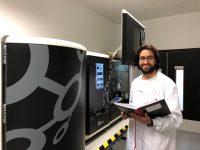Finding the next generation of cancer therapy
28 Nov 2018 by Evoluted New Media
Having been awarded a grant from The Royal Commission for the Exhibition of 1851 – Carlos Julià is determined to reduce the cost of next generation cancer therapies by using a white blood cell ‘photocopier’…
Currently, cancer is treated with chemotherapy which, by itself, is a one-size-fits all type of treatment based on chemicals that kill the fast-dividing cancer cells in a non-specific way.
When a patient receives chemotherapy, those cancer cells are affected – and eventually killed – by the chemicals and, because of their lack of specificity, other healthy cells and tissues might be severely affected by it. This is demonstrated by side-effects that, in fact, can be very dangerous for the patient. Chemotherapy does not guarantee a successful cancer treatment. Instead, it normally involves a combination of other more targeted therapies such as the use of monoclonal antibodies that can minimise side effects on healthy tissue but, sometimes, it is not even possible to treat it at all.
Cell and gene therapies (CGT) for the treatment of cancer focus on cells that are programmed to specifically kill the cancer cells when being infused to a patient. This is the new horizon for cancer treatments in the field of personalised medicine but, as is often the case with new technology, it is extremely expensive to use.
After decades of research, these new cell therapies are finally undergoing clinical trials with amazing outcomes, and two of them are already approved by the US Food and Drug Administration (FDA)[1], meaning they are ready to be used in any patient in need. Compared to traditional treatments, both approved cell therapies have impressive complete remission rates in patients, but at a cost well above $350,000 per patient, per dose.
Cutting the cost
A significant percentage of that cost is in its manufacturing step, prior to patient infusion. It is a very complex, manual process, and lacks consistency being prone to contamination, thus sharply increasing its production costs. Here is where Aglaris Limited, the company I work with, is trying to find a better solution. Over the past years, Aglaris has developed automation and monitoring technology for the CGT industry, and my PhD project stems from that hard work of the Aglaris team. The project comprises the development of a cartridge to automate and streamline the currently expensive manufacturing step and contribute significantly to making CGTs widely available for patients, not only for the few that could afford it.This is the new horizon for cancer treatments in the field of personalised medicine but, as is often the case with new technology, it is extremely expensive to use.We have a second impact on the cost; we make the manufacturing process faster and more reliable. This is vital as patients receiving CGTs are often critically ill – losing time or a sample of their precious cells due to a delicate manufacturing protocol could have serious consequences for the patient and prolong their hospitalisation.
Thanks to the collaboration with Aglaris, Dr Qasim Rafiq from University College London (UCL), and the financial support from the Royal Commission for the Exhibition of 1851 through an Industrial Fellowship, I am able to undertake my PhD research project in one of the fields of the future.
The successful outcome of this project would help to reduce the cost and increase the quality of the CGTs that are currently being approved by regulatory administrations. This is an excellent and timely opportunity for me as a researcher to undergo a PhD project that could eventually have a positive impact in people´s lives.
References:
Auth or:
or:
Carlos Julià is Cell Culture and Bioreactor Process Development Scientist at Aglaris





